Niagara Falls
The
Maid Of The Mist
a history

A view
of the Maid of the Mist passing in front of the American Falls
As early as 1834, small boats were
utilized to transport people across the Niagara River. This would remain the only method
available until 1848 when the first International Suspension Bridge was completed. It was
between 1834 and 1848 that the Maid of the Mist I was launched to take up the service of
ferrying people across the river in a much larger boat to the satisfaction of the people
who had serious reservations about the safety of using the much smaller boats.
The Maid of the Mist I was launched on
May 27th 1846. this boats ferry service was short lived when the first International
Bridge was completed. Following completion of the bridge, most people transited the
Niagara River by was of the bridge instead of the ferry. The Maid of the Mist had to take
up the role as a tourist sightseeing service to remain viable.
On July 14th 1854, the Maid of the Mist
II was launched. It was much larger than the first. This boat was a steam propelled paddle
wheeler with a single smoke stack.
In 1861, because of a financial crisis
and the coming American Civil War, the Maid of the Mist was sold at action to a Canadian
firm on the condition that it be delivered to Lake Ontario. There was only one way to get
there and that meant taking the boat downstream through the Great Gorge Whirlpool Rapids
and the Whirlpool. This trip was undertaken by Captain Joel Robinson and two crew members
on June 6th 1881. To read more about the exploits of Captain Robinson refer to the
Daredevils Hall of Fame section.
The Maid of the Mist III was launched
in June of 1885. It was 70 feet long and much more elegant.
The Maid of the Mist IV was launched in
1892 on the American side of the Niagara River.
On April 22 1955, a fire of unknown
sources caused two Maid of the Mist boats to burn at the Canadian docks.
On July 28 1955 a new Maid of the Mist
boat was launched to replace those boats destroyed by fire. This boat was christened
"Maid of the Mist V". It was built entirely of steel.
In June of 1956, the sixth boat in the
Maid of the Mist fleet was launched. It was christened Maid of the Mist II.
|
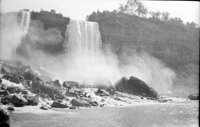 |
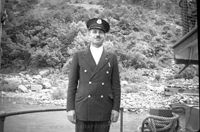 |
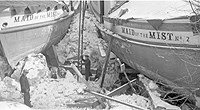 |
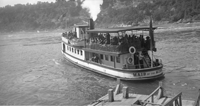 |
|
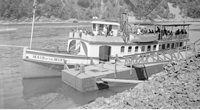 |
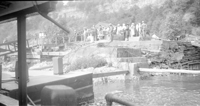 |
 |
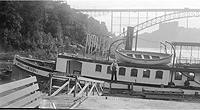 |
|
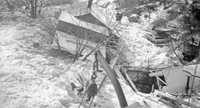 |
Pictures of
the Maid of the Mist
Courtesy of
Larry Stroobandt |
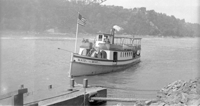 |
|
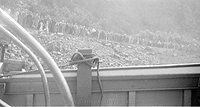 |
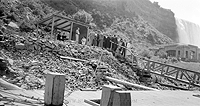 |
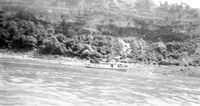 |
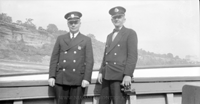 |
|
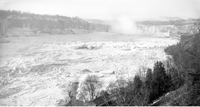 |
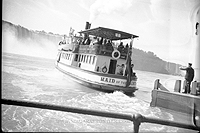 |
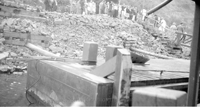 |
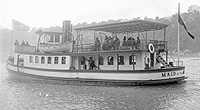 |
|
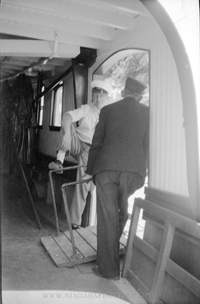 |
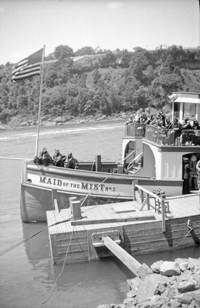 |
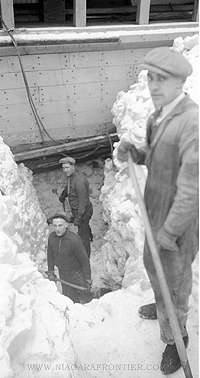 |
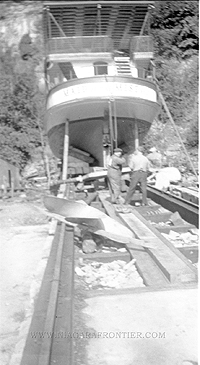 |
|
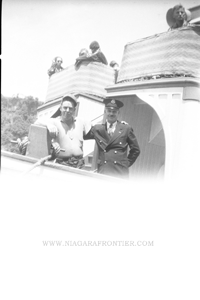 |
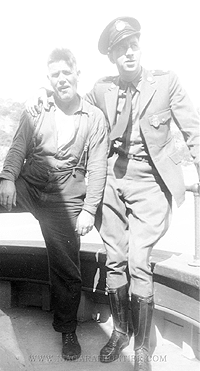 |
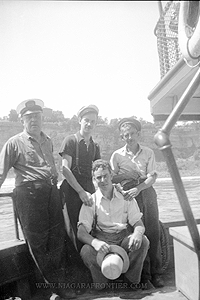 |
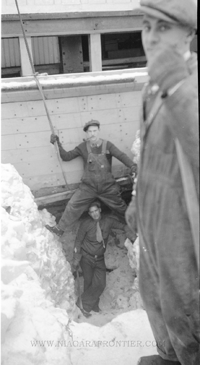 |
On June 9th 1960, the Maid of the Mist
II was instrumental in the rescue of seven year old Roger Woodward who had accidentally
gone over the Horseshoe Falls. In 1983, the Maid of the Mist II was sold. Today it
continues service as a Missionary ship on the Amazon River. Refer to
Daredevils Hall of Fame section to
learn more of Woodward's accident and the subsequent rescue.
In 1971, the Maid of the Mist
Corporation was purchased by James Glynn of Lewiston, New York.
In 1976, Maid of the Mist IV was
launched. This boat could carry 200 passengers. The Maid of the Mist IV is 72 feet (22m)
long and has a beam of 24 feet (7m).
On June 6th 1983, the Maid of the Mist
V was launched into service. It was built of steel construction and could carry 300
passengers. This boat became the ninth boat launched during the history of the Maid of the
Mist Company.
In 1990, the Maid of the Mist VI was
launched into service. The all steel double deck boat is capable of carrying 600
passengers at a time.
On Friday May 30th 1997, the first
section of the new Maid of the Mist VII arrived on a flatbed trailer to the Maid of the
Mist docks. The first piece of the hull measuring 31 feet long by 12 feet wide by 13.3
feet high weighed 27,730 pounds. Over the following weeks the new boat was delivered in 14
separate pieces including 8 additional pieces of the hull. When assembled and welded
together the new Maid of the Mist VII was 80 feet long, weighing 145 tons and will capable
of carrying 582 passengers. The Maid of the Mist VII replaced the smaller Maid of the Mist
III which is being used only on a standby basis.
The new Maid of the Mist VII was
officially launched into service on Friday July 11th 1997. This vessel was originally
built at Cartier Construction in Belleville, Ontario.
The dock is located at the edge of the
Niagara River at the base of Clifton Hill.

A view
of the Maid of the Mist in turbulent waters at the base of the Horseshoe Falls
The water elevation at
the Maid of the Mist docks:
during daytime is 327 feet (100m)
above sea level.
during nighttime is 321 feet (98m)
above sea level.
The difference of water level at the
Maid of the Mist docks between daytime and nighttime is 6 feet (2m) in height.
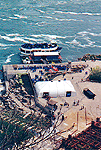
The Maid
of the Mist dock facilities (Ontario)
Legend of the Maid of
the Mist
The most famous legend in Niagara Falls
is that of the Maid of the Mist, the Thunder God Hinum and the origin of the Falls of
Niagara. This legend originated with the Neuter Indian Nation which occupied the Niagara
District when the first French priests came to their villages to preach Christianity.
The story goes that Indian tribes were
dying of an unknown cause. Each year the Indians were sending canoes filled with fruit
over the Falls to appease the God Hinum and his two sons who the Indians believed lived
behind the Falls. When the Indian luck did not improve, they felt that their God was not
satisfied. Consequently they began sacrificing their most beautiful Indian maiden each
year but still their luck did not improve.
One year, Lelawalo, the daughter of the
Chief of the tribe was sacrificed to the spirit of the Falls. She was placed into a canoe
filled with food and sent on her way over the mighty cataract. Legend says that this
Indian maiden was caught in the arms of the God's sons. Recalling that she had been sent
to her death, the Indian maiden agreed to take one of the sons as her husband with one
condition.
One of the sons relented and told her
that there was a poisonous snake that lived at the bottom of the river would get hungry
once a year and crawl to the where the Indians were and poison their water. The Indians
would drink the poisoned water and die. After burial, the snake would return to consume
their bodies.
The Indian maiden convinced the
youngest son of the God to allow her to go back to the tribe one more time to tell them
what the snake was doing and how to kill them with spears. One night when the snake
returned , the Indian braves were waiting and speared the snake. The snake crawled back to
the edge of the Falls and died with its body shaped like a horseshoe.
Legend has it that the shape of the
Falls became horseshoe shaped from the body of the snake. It is said that it remains to
this day, showing that the Gods are still protecting the Indians against evil spirits.

The Maid
of the Mist at the base of the Horseshoe Falls
To learn more about the
early history of Niagara Falls,
please visit the Chronicles of our Early
Settlers section.
The Early History
of the
Maid of the Mist
selection from the
Chronicles of our Early Settlers section
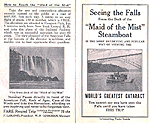
The
Front Cover of an Early Maid
of the Mist brochure
courtesy
of Sarah Dorn
In 1807, Christian Dow speculated about
the possibility of man crossing the Niagara River below the Falls as he watched wild ducks
swimming back and forth across the span of the river.
The location of Indian ladders down the
gorge wall at the site of the current Maid of the Mist dock are seen in early guide
pamphlets. Until 1795, when Mrs. Simcoe (Governor John Graves Simcoe's wife) visited, the
ladders were the only way down the gorge embankment. In her diary, she wrote: "Mr.
Pilkington was desired to place ladders to form a stairway down the bank".
Mr. Pilkington did arrange the ladders
in a stairway fashion but it was still a very daring and dangerous undertaking.
In 1818, William Forsyth built a
stairway at the former ladder site to facilitate access to his row boat ferry service
which Forsyth was planning to operate.
In 1818, William Forsyth along with
American hotel owner Parkhurst Whitney, began the first row boat ferry service crossing
the Niagara River below the Falls. Forsyth did so without at first obtaining government
permission.
Parkhurst Whitney built the first
stairway down the bank of the Gorge on the American side.
When Forsyth finally asked for
government permission, Thomas Clark strongly objected to Forsyth's aggressiveness, and
used his influence to lobby politicians to prevent Forsyth from obtaining the ferry
service lease.
With the support of Thomas Clark,
Christopher Boughner was granted the government lease to operate the ferry service. The
lease was to begin on December 25th 1820 for seven year period.
William Forsyth was outraged at the
government decision to grant Boughner the ferry lease. To further infuriate Forsyth,
Boughner built a stairway to the ferry dock adjacent to Forsyth's stairway.
Forsyth knew that Boughner had a number
of debts. Forsyth went about buying up all of Boughner's debts until Forsyth became
Boughner's sole creditor. Forsyth began applying pressure to have Boughner pay his debts
knowing full well that Boughner could not.
Boughner finally caved into Forsyth's
pressure and gave up his rights to the ferry service to Forsyth in exchange for Forsyth
canceling Boughner's debts. After fourteen months, Boughner was out of the ferry business
while William Forsyth was in business again.
Thomas Clark was very angry over how
Forsyth had forced Boughner to give up his ferry service to Forsyth.
On December 21st 1821, Thomas Clark
wrote a letter to the Government of Upper Canada outlining what Forsyth had done to
Boughner in order to take over the ferry service. Clark recommended that the government
revoke Forsyth's ferry lease and award it to someone else.
On January 23rd 1822, acting on the
recommendation of the Lieutenant Governor of Upper Canada, the ferry service lease of
William Forsyth was rescinded for non-payment of the quarterly fee that had not bee paid
to the government.
On April 30th 1822, the government
granted the ferry service lease to George Milmine. He was allowed to operate the service
for a three year term.
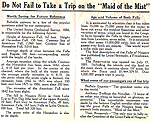
The
inside page of an Early Maid
of the Mist brochure
courtesy
of Sarah Dorn
On April 15th 1825, Thomas Clark and
Samuel Street applied for and granted a twenty-one year lease. The granting of their lease
hinged on their commitment to build a carriage road down the side of the gorge to the
ferry landing. Their lease expired in 1846. The road to the ferry landing cost $5,000 and
was paved with cobblestone. It had a hairpin turn during the descent. This turn was until
several years ago, still as it was when built by Clark and Street. Modernization has now
eliminated this turn.
In 1825, the stairway on the American
side was replaced with a spiral stairway built by the Porter Brothers, who owned the
American Falls at the time.
Augustus and Peter Porter applied for
and were granted the rights to operate the American ferry service. The Porter brothers
attempted to blast a road along the gorge wall approximately 100 feet north of the
American Falls. The road was never completed because rock falls and washouts forced the
Porter brothers to abandon their plans.
The Porter stairway remained in
operation until 1844 when the stairway was augmented by an incline railway cut into the
gorge wall. The new incline railway was water powered.
The crossing time with a large rowboat
took eight minutes. Fares ranged from 18¾¢ in summer months and 25¢ in the winter
months.
During the 1840's, more than forty
rowboats were plying their trade on the lower Niagara River. Rowboats were now being
employed in taking tourists upstream to the base of the American and Horseshoe Falls.
Throughout the period of rowboat use, there are no records of any accidents.
On November 6th 1845, Adam Fralick was
granted a ferry license. He was restricted to operating his ferry service 2.5 miles
downstream of the Falls.
On January 11th 1850, management of the
ferry service was given to the Customs Branch of the Inspector Generals Office.
On April 29th 1853, Gilbert Mickmicken
was awarded the ferry lease.
In 1846, the Niagara Falls Ferry
Association received its charter from the State of New York to operate a steamboat ferry
service.
In May 1846, an awkward looking large
steamship with two smoke stacks was launched. It was christened "Maid of the
Mist". This 100 ton ferry was commanded by Captain Filkins and Captain George Synes.
The ferry operated from a dock located just south of the Railway Bridge.
In 1848, the Falls View Suspension
Bridge was completed. Ferry service across the Niagara River became obsolete overnight. It
was now quicker, easier and cheaper to use the bridge to cross the Niagara Gorge.
In order to remain in business and to
keep it profitable, the Niagara Falls Ferry Association began using the "Maid of the
Mist" to take tourists on trips past the base of the American Falls and the Horseshoe
Falls.
On January 9th 1851, the Maid of the
Mist sank in twenty feet of water while moored at its Bellevue wharf. The cause was
attributed to the build up of heavy snow. The Maid of the Mist was re-floated. It had
sustained little damage. It remained in service until 1854.
On July 14th 1854, the new "Maid
of the Mist" was launched. The new boat was a steam driven paddle wheel boat
measuring 72 feet (22m) long and 17 feet (5.18m) breadth of beam. It had an eight foot
(2.4m) draught and was powered by a 100
horsepower engine. This ferry was commanded by Captain Joel E. Robinson. Passengers were
given oil skin coats and caps to keep them dry. This Maid of the Mist made its last trip
in the Fall of 1860.
On June 6th 1861, after the Maid of the
Mist had been sold, Captain Robinson and a crew of two, sailed the Maid of the Mist
through the Great Gorge Rapids on route to Montreal. It was a perilous journey but
successful. Captain Robinson retired after the trip through the rapids. (see
Daredevils Section)
From 1860 to 1885, there were no
steamboat ferries in the Niagara River below the Falls.
In 1883, a replica of the Maid of the
Mist ferry boat was sent through the Great Gorge Rapids with no one on board as a
publicity stunt.
By 1868, there were now two suspension
bridges in operation across the Niagara Gorge.
In 1878, the railroads began bringing
tourists back to the Falls in large numbers. This spurned the building of a new Maid of
the Mist steamboat ferry.
In 1884, R.F. Carter and Frank Le Blond
of the Village of Clifton invested $10,000 into the building of the new Maid of the Mist.
The third Maid of the Mist was built at
the dock on the Canadian side. It was launched into service in 1885. A sister ship was
built on the US side.
In 1894, the International Railway
Company built a passenger incline railway down the embankment on the Canadian shore.
In 1906, the American incline railway
was changed from being water powered to electrical power.
In 1938, the great ice jam that
destroyed the Honeymoon Bridge threatened to destroy the two Maids of the Mist tour boats.
Both survived, only to be destroyed by fire on April 22nd 1955. The fire was started when
a spark from a welders torch ignited.
April 22, 1955
Niagara Falls Fire Chief Dies-Boats Damaged
Both Maids of the Mist are Razed - Chief Collapses Fighting Fires
Fire Chief John C. Shapton died in the Greater Niagara General Hospital
at 12:35 pm following a heart seizure suffered 90 minutes earlier while
he was directing firefighting operations at the Maid of the Mist landing
where the fire almost completely destroyed the two Maids of the Mist
mounted on their winter births.
Shapton, age 59, was rushed to the hospital by his son Thomas, also a
city fireman after collapsing at the dock where the firemen were pumping
water from the Niagara River.
Chief Shapton was the only full-time chief in the history of the fire
department. He had heroically led the battle from the time the fire
started at approximately 10:15 a.m.. Fire swept through the two vessels
in 10 minutes time feeding on a tar canvas covering. Only the hulls were
still intact. Frank Le Blond, president of the Maid of the Mist
Steamship Company estimated the replacement value at $350,000.
Inspectors from the Canadian Steamship Comapny after examining the
damage stated that both maids may be able to operate in the summer. At
first both boats were believed a total loss but inspectors found that
only the upper sections of the boats burned in the flash fire. In event
that both boats cannot be fixed, Mr. Le Blond will attempt to secure
several launches to operate with.
The fire started in the starboard corner of the large boat when workmen
were working with torches. It was first spotted by Thomas Masson, he's a
carpenter who suffered cuts and a sprained arm fighting the fire.
Wilford Storm another employee suffered bruised ribs. Twenty-eight men
were working on the two vessels when the flames broke out. The fire
spread rapidly and fed on the tar canvas on both boats.
No accidents or injuries have occurred on the Maid of the Mist except
when one of the vessels was disabled when a drift log fouled it's
propellers. Captain Malloy signalled Captain Carter for assistance and
got a line aboard from the other Maid and towed the crippled boat back
to the American side.
1916- Two other accidents were recorded. On September 21st, when the
Maid of the Mist ran aground beside Goat Island. The captain ordered the
passengers to put on life preservers and prepare to launch lifeboats but
the boat pulled itself free from under its own power.
October 2nd 1916 on the last trip of the year when a propeller shaft
broke near the foot of the Horseshoe Falls. The captain ordered the
anchor cast. Passengers were taken to Goat Island but the crew remained
on the boat all night until it was removed the next morning.
April 23rd 1955 - Maids of the Mist to sail again. The new looks Maid of
the Mist to sail the summer. They will be launch type vessels without
upper structures.
April 26nd 1955 - Steamship inspectors approve rebuilding of Maid's of
the Mist. Le Blond estimates it will cost $150,000. They have abandoned
the idea to operate without upper deck because it is not financially
viable. With main deck large vessel can carry 140 people and the small
boat can carry 100 people.
April 30th 1955 - New Maid of the Mist will sail in Niagara. A contract
signed by Frank La Blond, president of the Maid of the Mist Company and
the Russell-Hipwell Shipbuilding Company of Owen Sound for the
construction of the new Maid. The single decker will cost approximately
$100,000. It will be prefabricated and moved into the Niagara gorge in
sections. Le Blond hopes to have the new vessel in operation in August.
May 11th 1955 - Maid operation will resume in a months time. A steel
hull made in Holland and moored at Hamilton Harbour for two years was
skidded down into the gorge Tuesday. The hull was moved and lowered into
the gorge lasting ten hours. A deck and wheelhouse will be constructed
immediately. Ship will have a 35 passenger capacity with two diesel
engines and be 40 feet long and weighing eight tons.
June 1st 1955 - Operate new Maid by mid-June. Forty foot steamer nears
completion powered by two - 100 horsepower diesel engines.
June 13th 1955 - Launch of the little Maid into the Niagara River.
July 11th 1955 - The first of big Maid's moving into the gorge. The
first of four sections that will be welded together. The vessel will be
65 feet long and have a 100 person capacity. It will be the first of two
ships to be built.
July 12th 1955 - Word has it that wood from the two burned out Maids of
the Mist will be turned into wooden nickels. it is a promotional stunt
by Niagara Falls Chamber of Commerce. Fifty thousand wooden nickels will
be made.
July 29th 1955 - The new Maid of Mist was christened and is ready for
service. Thousands of citzens witnessed the launching ceremonies of the
Maid of the Mist 3.
August 4th 1955 - The new Maid of the Mist 3 begins regular sailings.
August 17th 1955 - The wooden nickels are on sale.
In less than one month after the fire,
a forty foot yacht was brought down to the ferry dock along the service road on the
Canadian shore. This boat was named the "Little Maid of the Mist".
The Maids of the Mist tour boats need
to be taken out of the water before November 1st each year. Ontario Hydro reduces the
water level on that date so that the boats would be not be able to reach their winter
cradles
Since 1971, the Maid of the Mist Tour
Boat Company has been owned by the Glynn family of Lewiston, New York.
It is an American Company however the boats are registered from St.
Catharines, Ontario, Canada.

The Maid
of the Mist Tour Boat facilities at the base of the Prospect Point Tower (New York)
*the
Maid of the Mist cannot be launched into the waters of the Niagara River until
after April 1st of each year. The presence of ice in the river may delay the
date of the launch.
The
New Era
of the
Maid of the Mist
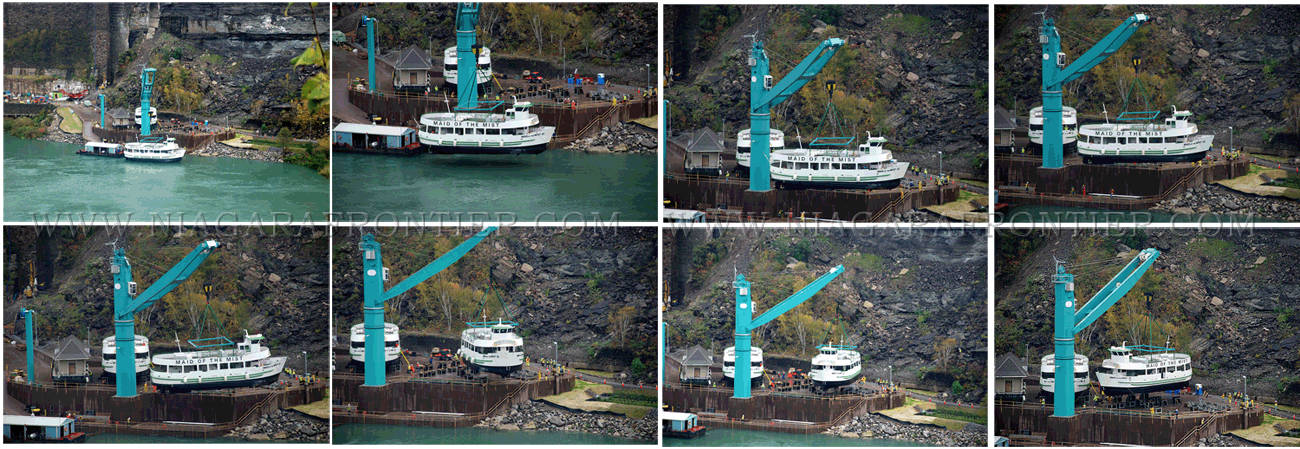
The First Time
Lifting the Maid of the Mist VI and the Maid
of the Mist VII onto Winter Dry Docks - Niagara Falls USA
October 31st 2013
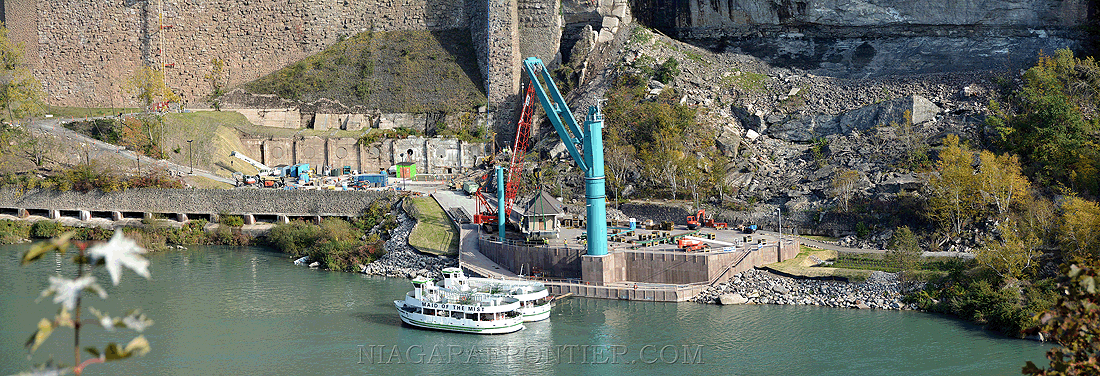
Preparing to lift the Maid of the Mist boats
onto winter dry-docks - Niagara Falls USA
October 29th 2013
The entire Liebherr Crane, weighing nearly 160 tons, will be used to lift the Maid of the
Mist boats out of the Niagara River
for storage at its new docking site during the winter months. The crane is
anchored 70 feet (21.3m) into the bedrock.
The Maid of the Mist, which has operated tour boats at the base of the
Falls since 1846 and owned by the Glynn family since 1971, lost its
Canadian contract in 2009 when the Niagara Parks Commission (Ontario) elected to reopened the Glynn's
tour boat contract to
open bidding as a result of lawsuits and public scrutiny of the
company's no-bid contract.
The Maid was outbid by Hornblower Cruises and Entertainment, a
California-based cruise operator, and lost its storage facilities
located on the Canadian side of the gorge along with the right to
operate in Ontario. Hornblower gained rights to the site at the beginning
of 2014.
That process netted the deal with Hornblower, a 30-year contract
Canadian officials estimate will generate more than $500 million in
revenue to the parks governing body, or $300 million more than it
received in its previous agreement with Maid of the Mist.
With no storage facilities on the American side of the gorge, the
company was in danger of losing its ability to operate the attraction
and it's ultimate extinction following a legendary and colourful history.
The Maid of the Mist had an existing lease with the State of New York
signed in 2002, which allows the company to run boat tours from the
American side of the lower Niagara Gorge. The Maid of the Mist lease on
the American side of the Niagara River expires in 2043.
In 2012, New York State Governor Andrew Cuomo joined the Glynn's in announcing an amendment to
the Maid of the Mist's existing 40-year contract that was signed in 2002.
This amendment will add
the State of New York take in an additional $105 million over the course of
agreement and see the Maid of the Mist Tour Boat Company spend an additional $32 million to convert
the historic Schoellkopf Power Station site into a dry dock facility for
the boats and to enhance the historic aspects of the site to create
another attraction for visitors.
In 2012 Maid of the Mist faced closure in the absence of storage space
for its boats on the New York side of the river. Governor Cuomo struck a
deal to keep the boats running and produce increased revenues for
Niagara Falls State Park. The Maid of the Mist Corporation agreed to
invest $32 million in the former Schoellkopf Power Station site near the
falls to make it suitable for the winter storage and maintenance of its
boats. Under the memorandum, the company agreed to increase its license
payments to the New York State Office of Parks, Recreation and Historic
Preservation, totalling $105 million over 30 years—three times the
revenues that were projected for the 30-year period when a contract was
initially approved in 2002.
The Maid of the Mist Company will build two new electric catamaran-style
vessels Maid of the Mist vessels. Both will be able to carry about 520
passengers each.The catamaran hull is welded 5086 H116 aluminum, and is
27.5 m (90 ft) long and 10.4 m (34 ft) wide, with a 1.7 m (5 ft 7 in)
draft, and can carry 500 people. Each boat has 316 kWh batteries
powering 400 kW motors.
Designed by Propulsion Data Systems, the new totally integrated vessels
are currently under construction by Burger Boat Company in Manitowoc,
Wisc. In mid-May, the modules will be transported to Niagara Falls and
lowered onto the Maid of the Mist dry dock and maintenance facility for
assembly. Following completion of construction, launch and
certification, the new vessels will be placed into service.
ABB will supply a comprehensive integrated power and propulsion solution
for the new-build vessels, including lithium-ion battery packs and an
onshore charging system, enabling sustainable operation with maximum
reliability.
Powered by ABB’s zero-emission technology, the two fully-electric
vessels will take tourists to the heart of the Niagara Falls,
undisturbed by engine noise or exhaust fumes. Batteries will be
recharged for seven minutes after each trip to 80% capacity, allowing
for maximum efficiency and battery life. A ride is 20 minutes
Each of the vessels will be powered by a pair of battery packs with a
total capacity of 316 kWh, split evenly between two catamaran hulls.
Having two fully independent power systems on board will increase the
resilience of operations by creating a redundancy.
The vessels will charge between every trip while passengers disembark
and board. Shoreside charging will only take seven minutes, allowing the
batteries to power the electric propulsion motors capable of a total 400
kW (563 HP) output. The power setup will be controlled by ABB’s
integrated Power and Energy Management System (PEMS), which will
optimize the energy use on board.
The hull of the new vessels features an icon of the electricity symbol
within a water droplet surrounded by a turbine with Niagara Falls in the
background. The color scheme is environmentally-friendly green combined
with the blue of the water.
The new vessels are named after Tesla, the genius inventor whose
lifelong dream had been to harness the energy of the natural wonder of
Niagara Falls.
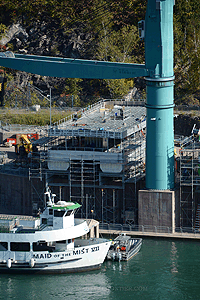
the New Maid of the Mist Being Built
Maid of the Mist III – built 1970 sold 1992 NLD 1998 Hike Metal
Products, Wheatley ON
Maid of the Mist IV – built 1974 scrapped 2013 Hike Metal Products,
Wheatley ON
Maid of the Mist V – built 1983 scrapped 2013 Hike Metal Products,
Wheatley ON
Maid of the Mist VI (1990) - will be retired from service when the
new vessels begin operating
Maid of the Mist VII (1997) - will be retired from service when the new
vessels begin operating
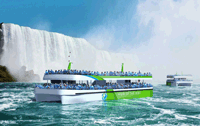
the New Maid of the Mist